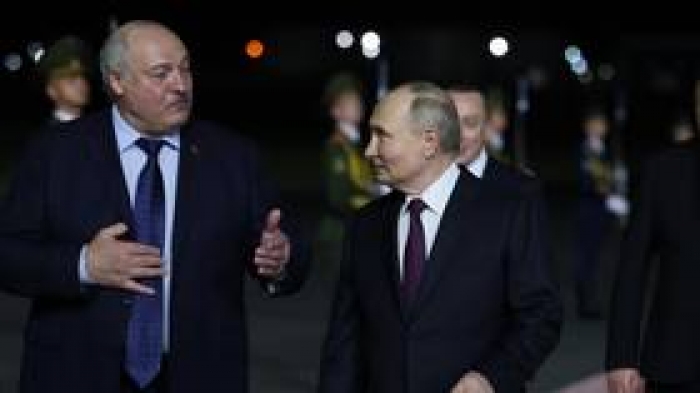RUSSIAN PERSPECTIVE
Putin to discuss ‘second phase’ of nuclear drills with ally
Russian President Vladimir Putin has arrived in Belarus for a two-day state visit that will include talks on the former Soviet republic’s involvement in nuclear weapons drills.
“We’ll talk about the second phase of the exercise,” Putin said after being greeted by Belarusian President Alexander Lukashenko on Thursday at the Minsk National Airport. “This is related to direct participation of our Belarusian friends and colleagues in these events.”
Russian troops began the first phase of the tactical nuclear exercise on Tuesday in the Southern Military District, which includes Crimea and four formerly Ukrainian territories in the Donbass region. Moscow said the drills are meant to demonstrate its ability to respond to external threats, thereby deterring further escalation of the Russia-Ukraine conflict by Kiev’s Western backers.
The exercise involves delivery of nuclear weapons to troops from storage sites, the arming of missiles with tactical nuclear warheads, and covert deployment of such weaponry.
After the Kremlin announced the drills earlier this month, citing an ”unprecedented” escalation of tensions with the US and its allies over Ukraine, Lukashenko immediately ordered similar exercises to test Belarus’ nuclear-capable weapon systems, including Iskander missile launchers.
Last year, Putin agreed to store a small number of tactical nuclear weapons in Belarus, after Lukashenko made a “friendly request” for such a deterrent. Back then, Lukashenko also stated that he would not hesitate to use them if his country is attacked.
French President Emmanual Macron and other Western leaders have recently hinted at potential deployment of NATO forces in Ukraine and the use of their weapons by Ukrainian troops to strike targets deep inside Russian territory.
Putin said he previewed his visit to Belarus by discussing issues of bilateral cooperation with members of the Russian cabinet. That meeting covered such topics as security, energy and agriculture issues. Some other Russian leaders are scheduled to arrive in Minsk on Friday to participate in the talks.
Lukashenko invited Putin for the visit, which marks the Russian leader’s second foreign trip since being sworn in for his fifth term as president on May 7. Putin traveled to China last week for talks with President Xi Jinping, and he’s scheduled for a state visit to Uzbekistan on May 26-27.
The state-run press service in Belarus said Lukashenko’s talks with Putin will cover the full range of relations between the countries, including trade, humanitarian issues, and joint projects.
WESTERN PERSPECTIVE
Ukraine's long-range glide bomb blunted by Russian jamming
Russian jamming has kept many of Ukraine's relatively new long-range GLSDB bombs from hitting their intended targets, three people familiar with the challenges told Reuters.
Ukraine over the last year sought weapons with longer ranges than the 43 miles (69 km) of U.S.-provided GMLRS rockets so Kyiv could attack and disrupt Russian supply lines and muster points.
To answer that call, Boeing Co (BA.N) offered a new weapon to the Pentagon with a 100-mile (161-km) range, the Ground-Launched Small Diameter Bomb (GLSDB). The glide-bomb has small wings that extend its reach, and it is comprised of the GBU-39 Small Diameter Bomb (SDB) and the M26 rocket motor, both of which are common in U.S. inventories and relatively inexpensive.
But the GLSDB's navigation system, which enables it to be steered around obstacles like mountains and known anti-air defenses, has been targeted by Russian jamming, the three people briefed on he matter said.
While Boeing has said the weapon can defeat some jamming, one of the sources said it would take Boeing months to fix.
Boeing and Ukrainian authorities did not immediately respond to a request for comment.
The bomb is made jointly by SAAB AB (SAABb.ST) and Boeing, and it was in development well before Russia's full-scale invasion of Ukraine in 2022.
Jamming happens when huge amounts of energy are broadcast into an area, overwhelming a device's signal. Russia has used the tactic on Ukrainian radios, drones and even GPS-guidable Excalibur 155 millimeter artillery munitions.
Ukraine has been using GLSDBs since earlier this year and experts have noted that it has not performed well on the battlefield because of jamming.
Ukraine has also been using both short and long range Army Tactical Missile Systems (ATACMS) which have a range up to 180 miles (300 km).
Jamming on the battlefield in Ukraine is "simply a reality, and numerous weapon systems have had to contend with these and other countermeasures," said Tom Karako, a weapons expert at the Center for Strategic and International Studies.
"Whether such challenges are in turn countered with technical upgrades or simply alternative methods of employment, the utility of long range fires is going to persist."
RT/Reuters

